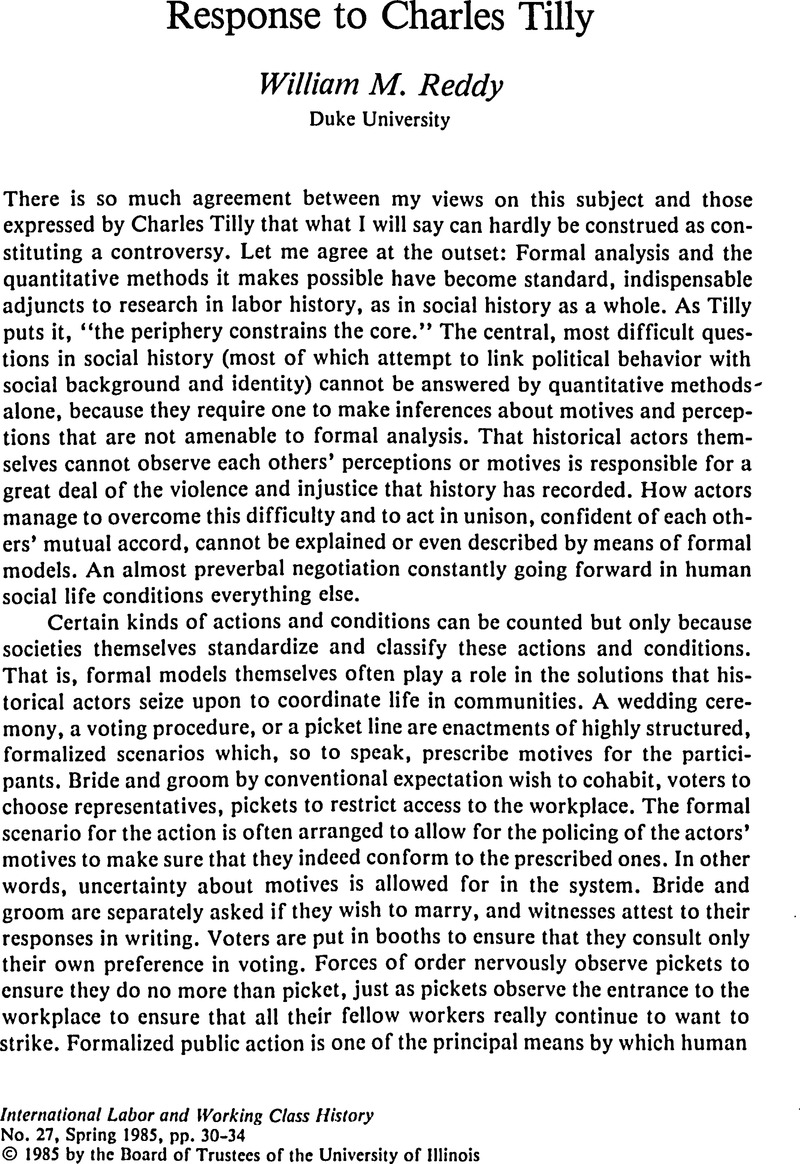Article contents
Response to Charles Tilly
Published online by Cambridge University Press: 16 October 2009
Abstract

- Type
- Scholarly Controversies
- Information
- Copyright
- Copyright © International Labor and Working-Class History, Inc. 1985
References
NOTES
1. Compare the highly divergent treatments of this subject in the following studies: Shorter, Edward, The Making of the Modern Family (New York, 1975)Google Scholar; Tilly, Louise A. and Scott, Joan W., Women, Work, and Family (New York, 1978)Google Scholar; Sabean, David, “Unehelichkeit: Ein Aspekt sozialer Reproduktion kleinbäuerlicher Produzenten: zu einer Analyse dörflicher Quellen um 1800,” in Klassen und Kultur: Sozialanthropologische Perspektiven in der Geschichtsschreibung, ed. Robert M. Berdahl et al. (Frankfurt, 1982), 54–76.Google Scholar
2. See, for example, More, Charles, Skill and the English Working Class (New York, 1980)Google Scholar; Harley, C. K., “Skilled Labor and the Choice of Technique in Edwardian Industry,” Exploration in Economic History Series 2, vol. 11 (1974), 391–414.CrossRefGoogle Scholar
3. I have argued this more fully in The Rise of Market Culture: The Textile Trade and French Society (New York, 1984).Google Scholar
4. Agulhon, Maurice, La république au village (The Republic in the Village), trans. Lloyd, Janet. (Paris, 1970; New York, 1982.)Google Scholar
5. These reflections are based on Sewell, William H. Jr., Work and Revolution: The Language of Labor from the Old Regime to 1848 (New York, 1980)CrossRefGoogle Scholar; Bonnell, Victoria, Roots of Rebel lion: Workers' Politics and Organizations in St. Petersburg and Moscow, 1900–1914 (Berkeley, 1983)Google Scholar; and also on Truant, Cynthia M., “Solidarity and Symbolism among Journeymen Artisans: The Case of Compagnonnage,” Comparative Studies in Society and History 21 (1979): 214–26CrossRefGoogle Scholar; Sonenscher, Michael, “Work and Wages in Paris in the Eighteenth Century,” in Manufacture in Town and Country before the Factory, ed. Berg, Maxine, Hudson, Pat, and Sonenscher, Michael (Cambridge, England, 1983), 147–72CrossRefGoogle Scholar; Jones, Gareth Stedman, “Rethinking Chartism,” in Languages of Class (Cambridge, England, 1983), 90–178.Google Scholar
6. See Bonnell, Victoria, Roots of Rebellion: Workers' Politics and organizations in St. Petersburg and Moscow, 1900–1914 (Berkeley, 1983)Google Scholar; Hanagan, Michael, The Logic of Solidarity: Artisans and Industrial Workersin Three French Towns, 1871–1914 (Urbana, 111., 1980)Google Scholar; Lequin, Yves, Les ouvriers de la region lyonnaise (1848–1914) (Lyon, 1977), 2 vols.Google Scholar; Wirtz, Rainer, “Widersetzlischkeiten, Excese, Crawalle, Tumulte und Skandale,” Sociale Bewegung und sozialer Protest in Baden, 1815–1848 (Frankfurt, 1981)Google Scholar. See also Crew, David F., Town in the Ruhr: A Social History of Bochum, 1860–1914 (New York, 1979)Google Scholar; Roche, Daniel, Peuple de Paris: Essai sur la culture populaire au XVIIIe siècle (Paris, 1981)Google Scholar; Brunet, Jean-Paul, Saint-Denis, la ville rouge, 1890–1939 (Paris, 1980).Google Scholar
- 1
- Cited by


